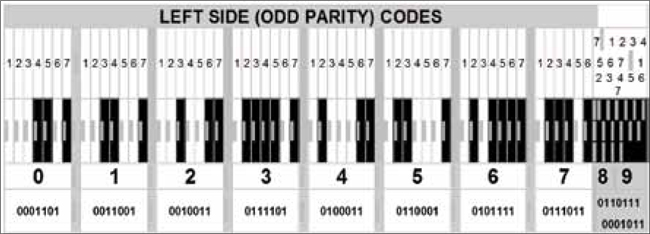Bar code first came in use commercially in 1966, but it was soon realised that there would have to be some sort of set industry standard. By 1970, the universal grocery products identification code (UGPIC) was written by a company called Logicon Inc. The first company to produce bar code equipment for retail trade (using UGPIC) was the American company Monarch Marking, and for industrial use, the British company Plessey Telecommunications, in 1970.
UGPIC evolved into universal product code or the UPC symbol set, which is still used in the US. In June 1974, the first UPC scanner was installed at a Marsh’s supermarket in Troy, Ohio. The first product to have a bar code included was a packet of Wrigley’s Gum.
Barcode is an optical machine-readable representation of data, which shows certain data about certain products. Originally, barcodes represented data in the widths (lines) and spacing of parallel lines, and was referred to as linear or one-dimensional (1D) barcodes or symbologies. They also come in patterns of squares, dots, hexagons and other geometric patterns within images termed as two-dimensional (2D) matrix codes or symbologies. Although 2D systems use symbols other than bars, they are generally referred to as barcodes as well. Barcodes can be read by optical scanners called barcode readers, or scanned from an image using special software.

There are many benefits of barcod systems which fullfill the needs of the users at different levels. Barcode data-collection systems result in faster and accurate data-capturing, lower costs, minimal mistakes and easier inventory-management.
Types of barcode systems
A barcode symbology defines the technical details of a particular type of barcode—the width of the bars, character set, method of encoding, checksum specifications, etc. Most users are interested in the general capabilities of a particular symbology than in the sharp technical details.
There are different types of barcode systems/methods employed in various fields based on the usage and operations.
Numeric-only barcodes.
Coda bar. Older code often used in library systems, sometimes in blood banks.
Code 11. Used primarily for labeling telecommunications equipment.
EAN-13. European article numbering international retail product code.
EAN-8. Compressed version of EAN code for small products.
Industrial 2 of 5. Older code which is not in common use.
Interleaved 2 of 5. Compact numeric code, widely used in industry, specially in air cargo.
Plessey. Older code commonly used for retail shelf marking.
MSI. Variation of the Plessey code commonly used in the USA.
PostNet. Used by the US postal service for automated mail sorting.
UPC-A. Universal product code seen on almost all retail products in the USA and Canada.
Standard 2 of 5. Older code not in common use.
UPC-E. Compressed version of UPC code for small products.
Alphanumeric barcodes.
Code 128. Excellent density and high-reliability code which is used worldwide.
Code 39. General-purpose code used worldwide.
Code 93. Compact code similar to Code 39.
LOGMARS. Same as Code 39, this is the US government specification.
2D barcodes.
PDF417. Excellent for encoding large amounts of data.
DataMatrix. Can hold large amounts of data, especially suited for making very small codes.
Maxicode. Fixed-length, used by United Parcel Service for automated package sorting.
QR code. Used for material control and order confirmation
Data code.
Code 49.
Retail barcodes. There are four barcode types commonly used for retail items.The data encoded is a number which can be used to uniquely identify the item. UPC A and UPC E are mostly used in North America, but are also found throughout the world. EAN 13 and EAN 8 are more popular in the rest of the world, but are also found in North America. In Japan, EAN 13 and EAN 8 are known as JAN 13 and JAN 8. Some retailers use their own proprietary barcode types which are usually based on either EAN or UPC barcodes.
[stextbox id=”info” caption=”Industry standards for barcodes and labels”]Bookland EAN. It encodes ISBN numbers used internationally to mark books
ISSN and the SISAC Barcode. ISSN system is used for identifying serial publications (print and non-print) while SISAC barcode symbol uses code 128 to uniquely identify each issue of a serial publication using the ISSN, date of publication, and volume or issue number.
OPC. Optical industry association barcode for marking retail optical products
UCC/EAN-128. Widely used data formatting model for Code 128
UPC Shipping Container Symbol. ITF-14[/stextbox]
DataBar Expanded, DataBar 14. Apart from identifying a product, barcodes are expected to supply production details, such as batch number and use by date. DataBar Expanded is a new symbology which can do this. It encodes the same number as EAN 13 or UPC A by using less space.




